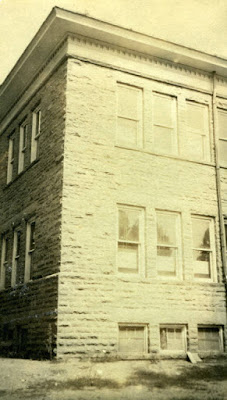The dense, hard, and fine-grained sandstone of the Catskill Formation once known as "Delaware Flags" and sold as "Blue Stone" during the heyday of the 19th century bluestone industry in northeastern Pennsylvania, was extensively documented by Ralph W. Stone of the Pennsylvania Geological Survey in August of 1922. He traveled with an assistant and frequently camped out along the way. Stone’s subsequent article,
The Flagstone Industry of Northeast Pennsylvania, Penn. Geo. Survey Bulletin 72, would appear in 1923. A selection of his 1922 photos from the
Pennsylvania Geological Survey Historical Photograph Collection follows
. Click the photos to enlarge.
 |
Delaware River bluff, State highway near Dingmans Ferry
|
Hand painted lettering on the rear of the cab and doors identified the vehicle as officially "Penna Geological Survey".
 |
Flagstone quarry, J. V. Hood, Dingmans Ferry, Pike County
|
John Van Sant Hood, teacher and Justice of the Peace in Dingmans Ferry in 1917.
Delaware River bluff and Milford Knob
|
The Devonian era mapped bedrock unit, Mahantango Formation, Hamilton Group.
 |
School house, built of Catskill sandstone, Milford
|
Note "stone from Dwarf Kill, five miles west of Milford," Pike County. Building contractor Edwin Stanton Wolfe, 1903.
 |
Flagstone quarry (Point quarry), Lackawaxen, Pike County
|
 |
Sandstone (Catskill) curbing, Lackawaxen, Pike County
|
 |
Sandstone (Catskill) from Kilgour quarry, Lackawaxen Station
|
 |
Sandstone quarry (Catskill), A. H. Woodward & Son, Kimbles, Pike County
|
 |
Sandstone quarry (Catskill), Standard Blue Stone Company, Kimbles, Pike County
|
The consortium of the Standard Blue Stone Company, based in New Jersey, included Frank Kilgour, son of the "Bluestone King" John Fletcher Kilgour (1841-1904). John F. Kilgour established the bluestone industry in Pennsylvania, gaining and losing two fortunes over the course of his life. In the early spring of 1922, the Standard Blue Stone Company, under court ordered Partition, auctioned off 7500 acres in twenty nine tracts located in Milford, Lackawaxen, Shohola, and Westfall Townships. Frank Kilgour, with Arthur W. Clapp of the Erie Railroad, would assume control of the company.
 |
Sandstone (Catskill) in canal aqueduct (abandoned), Lackawaxen, Pike Co.
|
Note "Building Stone. Shows chisel marks..." The Roebling Aqueduct, Delaware & Hudson Canal, opened in 1849.
 |
Flagstone quarry, John H. Bowen, Aldenville, Wayne County
|
 |
Flagstone at 514 Church Street, Honesdale, Wayne County
|
"Quarried at White Mills, six mile out. Measures 7' 11" x 22' 3". Home of Mrs. Anna O'Connell"
 |
Sly Lake (near Lake Como), Preston Township, Wayne County
|
 |
| Geologic Map of Pike County, Pennsylvania, 1978, Topographic & Geologic Survey | | | |
For the article, “Bluestone in Pike County,” Pennsylvania Geology, June 1978,
ninety-two inactive quarries were examined in Pike County. As noted by
the author, W. D. Sevon, the 19th century quarries were located on steep
sided slopes by the river within convenient reach of railroad transportation. Bluestone slabs were used for flagstones, veneer, tread, coping, sill, wallstone, slab stock, hearthstones and mantles. Peter Becker, Managing editor of the News Eagle, in his recent article,
A Legacy of Stone: Bluestone Quarries, profiles the last of the bluestone men, "Wayne Holbert, of Lackawaxen, still quarries and sells bluestone, a
business that started with his great grandfather in the late 19th
Century."















